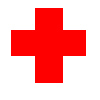 "ROAD
RASH" FIRST AID
"ROAD
RASH" FIRST AID
 "ROAD
RASH" FIRST AID
"ROAD
RASH" FIRST AID
Abrasions are very common sports injuries
that typically result from a fall on a hard surface. As the athlete falls
and/or slides on the ground or pavement, this friction causes layers of
skin to rub off. The skin is composed of an outer layer, the epidermis,
which provides protection, and a deep inner layer, the dermis, which provides
the firmness and flexibility of the skin. Abrasions typically refer to an
injury that removes these layers of skin.
Cyclists often refer to abrasions from crashes as 'road rash.' While a bike
crash has the potential to cause very painful and severe abrasion, most
abrasions are shallow scrapes that do not extend into the dermis, and therefore,
don't cause a great deal of bleeding. While there is often little or no
blood loss from an abrasion, there can be a great deal of pain, because
of the many nerve endings that are exposed.
Treatment for Abrasions
Conventional treatment of abrasions and "road rash" had one treat
the area by cleaning the wound with mild soap and water or a mild antiseptic
wash (hydrogen peroxide), and then covering the area with an antibiotic
ointment and a dry dressing. New evidence shows
that this treatment approach actually may cause tissue damage and increase
healing time. It has also been shown that the use of antiseptics,
such as hydrogen peroxide, "can actually cause harm to the tissue and
interfere with function, which can further increase the injury and lengthen
the healing process. Topical antimicrobials have been shown to be detrimental
to fibroblasts and other cells needed for wound restoration." (Basler,
et al, 2001)
While a severe abrasion should be seen and abraded by a physician,
there are some things you can do to help the healing process on your own.
The recommended method of treating abrasions and "road rash" injuries
includes the follows steps. First, because abrasions can easily become
infected, you should clean the area thoroughly and remove any dirt and debris.
Ideally, you want to irrigate the area with nontoxic surfactant (0.9% sodium
chloride or Shur-Clens) under some pressure (use a syringe if possible).
The area must be completely clean. If necessary, use a clean gauze to gently
scrub the area. Do not scrub vigorously, as this can
cause more tissue damage.
Use a semi-permeable dressing (Tegaderm, Bioclusive or Second Skin,
for instance) to cover the wound and attach the dressing to dry healthy
skin with adhesive tape. The dressing should be changed every few days.
Keep the wound moist until it has healed. A moist environment will promote
healing through improved cell migration and gaseous exchange, ease of removal
of excess exudate, protection from bacteria and other contaminants. (Basler
et al, 2001).
Your tetanus status is very important to avoid infection and if you aren't
certain when you had your last tetanus shot or if your last booster was
more than 10 years ago, you should see a physician and get a tetanus immunization.
Tetanus is an acute infectious disease in which the voluntary muscles go
into spasm. It is not only caused by stepping on a rusty nail. It can also
"develop in wounds in which the flesh is torn or burned." (See:
Adults Need Tetanus Shots, Too).
A Word About Deep Lacerations
While cleaning the skin abrasion you should look for any deep cuts that
may require stitches to heal properly. Cuts that continue to bleed after
15 minutes of direct pressure, or cuts that extend deep into the skin and
have edges that pull apart, may require stitches. If you are unsure of the
need for stitches, you should see a physician immediately.
Healing
With an abrasion the layers of skin removed will heal from the deeper layers
to the surface layers, and from the outer edges to the center. As healing
begins the area of the abrasion may look pink and raw. Over time, the wound
will form new skin that is pink and smooth.
Prevention
Prevention of abrasions is possible by wearing protective pads, and covering
any exposed skin with a layer of clothing. Generally, it is impossible to
predict when you will suffer from an abrasion, so it is wise to have the
necessary first aid supplies available in the event of an emergency.